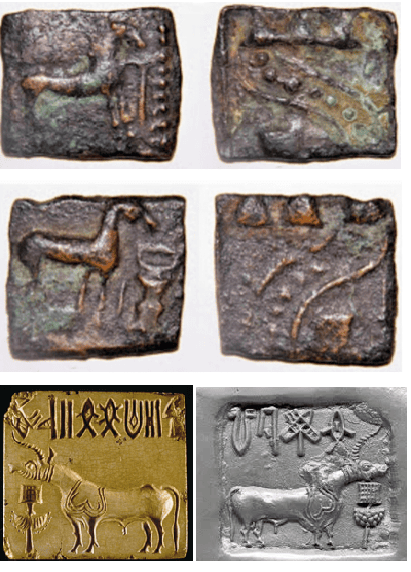UPSC Exam > UPSC Notes > History Optional for UPSC > Sangam Age: Coinage
Sangam Age: Coinage | History Optional for UPSC PDF Download
| Table of contents |

|
| Introduction of Coins |

|
| Roman Coins and Trade |

|
| Local Coinage of Sangam |

|
| Examples of Coin Donations |

|
Introduction of Coins
- During this period, the introduction of coins, including those inscribed with the Tamil-Brahmi script, marked a significant innovation. Coins were used in various contexts, as evidenced by the discovery of coin hoards comprising both local and foreign issues. These findings attest to the trade relations that existed between ancient Tamil Nadu and other regions.
- Monica Smith noted that the distribution of coins with different weight standards across regions suggests their use as a standard of value and a medium of exchange.

Monetization and Urban Centers:
- Although a fully developed money economy had not yet emerged, the use of copper coins indicated a degree of monetization. The use of coinage may have been limited to urban centers or among certain traders.
- Coins could have functioned as a form of bullion, with their value fixed based on the weight of the metal.
Roman Coins and Trade
- Roman coins were often used for their bullion value, with coins from the time of Augustus Caesar being particularly common. These coins were likely favored due to their high metal content and quality.
- The concentration of Roman coins in the Coimbatore region of Kongu suggests the area's importance in trade activities. Later Roman coins are found more frequently in southern India and Sri Lanka.
- Roman coins were also possibly used as ornaments during this period, as indicated by indirect references in Tamil literature.
Trade and Coin Usage:
- Trade based on coins was prevalent, with traders from distant regions amassing wealth in metal. While various materials were traded, profits were ultimately converted into metal wealth.
- The use of coins facilitated long-distance travel and the acquisition of wealth in easily transportable metal form.
Pyramidical Mode of Exchange:
- Coins may have represented fixed value units used primarily for significant transactions by a limited number of people, possibly traders and kings.

Question for Sangam Age: CoinageTry yourself: What did the use of coins in ancient Tamil Nadu primarily facilitate?View Solution
Local Coinage of Sangam
Introduction to Local Coins
- Local coins during the Sangam period likely held value based on their metal content. Kings might have minted these coins by smelting copper, and such coins could have been used for donations.
Types of Coins:
- Various types of coins, including punch-marked coins, Chera coins, Chola coins, Pandya coins, and Malayaman coins, were found throughout Tamil Nadu.
- Sangam literature mentions different types of coins such as kasu,pon, and kanam. Notably, kasu was sometimes used as an ornament rather than for commercial transactions.
Examples of Coin Donations
- Chief Kalankaikkanni Narmuticcheral donated 40,00,000 gold coins to Kappiyarry kappiyanar.
- Another chief, Atukotpattu Cherlathan, gave 100,000 kanam of coins to Kakkaippatiniyar.
Standardization and Authority:
- The coins likely had standard shapes and weights, which helped to legitimize the authority of the kings.
The document Sangam Age: Coinage | History Optional for UPSC is a part of the UPSC Course History Optional for UPSC.
All you need of UPSC at this link: UPSC
|
367 videos|995 docs
|
FAQs on Sangam Age: Coinage - History Optional for UPSC
| 1. What was the significance of Roman coins in trade during the Sangam Age? |  |
Ans. Roman coins played a crucial role in trade during the Sangam Age, as they facilitated commerce between the Roman Empire and the southern Indian kingdoms. These coins were widely accepted and became a medium of exchange, enhancing economic interactions and cultural exchanges. The presence of Roman coins in archaeological sites indicates the extent of trade relations and the influence of Roman currency in local economies.
| 2. How did local coinage develop during the Sangam period? |  |
Ans. Local coinage during the Sangam period emerged as a response to the growing trade and economic needs of the Tamil kingdoms. Various local rulers began minting their own coins, often featuring symbols, inscriptions, and images that represented their authority and identity. This local coinage helped in establishing a standardized system of trade and contributed to the economic stability of the region.
| 3. What are some examples of coin donations found in Sangam literature? |  |
Ans. Sangam literature contains references to coin donations, which were often made by wealthy merchants and rulers as acts of charity or religious offerings. For instance, donations to temples in the form of coins were common, and specific references can be found in texts like the 'Silappadikaram' and 'Manimekalai.' These donations not only highlight the economic practices of the time but also underscore the social and religious values of the Sangam Age.
| 4. What types of coins were commonly used in the Sangam Age? |  |
Ans. The Sangam Age saw the use of various types of coins, including punch-marked coins, which were made of silver and had simple designs. Additionally, coins known as 'kasu' were also prevalent, often made of copper and bearing the images of local deities or rulers. These coins reflect the diverse economic practices and the cultural significance of coinage during this period.
| 5. How did the introduction of coins impact the economy of the Sangam kingdoms? |  |
Ans. The introduction of coins significantly impacted the economy of the Sangam kingdoms by facilitating trade and commerce. Coins provided a stable medium of exchange, which simplified transactions and encouraged trade both within the region and with foreign traders. This economic development led to increased wealth, urbanization, and cultural exchanges, ultimately contributing to the prosperity of the Sangam Age.
Related Searches




















